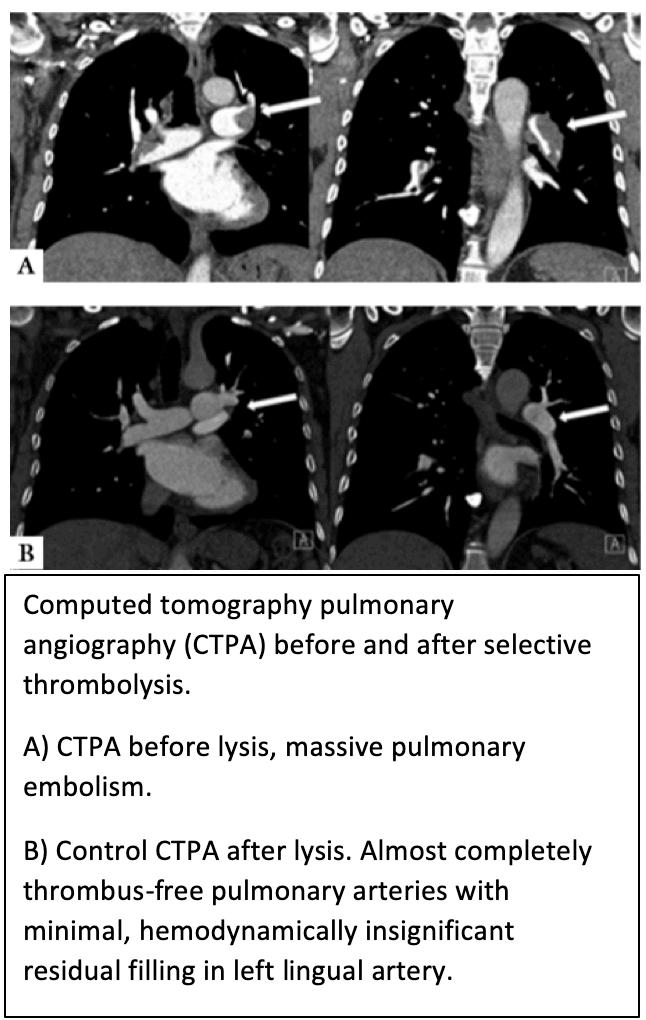
3 minute read
THERAPEUTIC USES OF INTERVENTIONAL RADIOLOGY
20 THERAPEUTIC USES OF INTERVENTIONAL RADIOLOGY By: Yasmeen Dhaher
Interventional radiology is a minimally invasive and image guided diagnosis as well as treatment of various diseases, many of which are life threatening. Venous thromboembolism, one of the diseases which has significantly high mortality rates according to statistics which suggest that 60,000-100,000 Americans die of Deep vein thrombosis and pulmonary embolism. With 10 to 30% of people dying within one month of diagnosis. (1) Therefore due to the frequency of venous diseases and its influence on quality of life quality, we chose to draw attention to the interventional radiological procedures that can provide fast and complete recovery from venous thromboembolism if applied in time.
Advertisement
The most important radiological interventions applied in the venous system are:
●Interventional radiological invasive treatment of massive pulmonary embolism. ●Treatment of acute lower extremity deep vein thrombosis. ●Treatment of deep vein stenosis (balloon dilatation, stenting). Inserting a temporary or permanent vena cava filter. ●Embolization of enlarged, inadequate venous networks (varicocele, embolization of large haemorrhoidal veins, embolization of dilated gastric, perigastric venous networks). ●Development of TIPS (transjugular intrahepatic shunt system shunt). ●Embolization of arteriovenous malformations. ●Sclerotization, laser treatment of superficial veins, varicose veins. (2)
The indication that allows the use of interventional radiological techniques is massive pulmonary embolism which is decided according to clinical classifications or the previously used Greenfried and Erbel-Meyer severity grouping, depending mainly on the severity of dyspnoea, tachypnea, syncope and chest pain, reduction in systemic blood pressure.
In the treatment of cardiac embolism with interventional radiology catheterization, we should primarily alleviate the severe hemodynamic catastrophe, which can be achieved most rapidly by cleavage and mechanical removal of thrombi (Figures A and B). The method can dramatically reduce the pressure in the pulmonary artery, which is critical to the success of therapy in gaining time. By rapidly relieving pressure, the patient is prevented from hearing in the acute first few
The function of selective fibrinolytic therapy following thrombus fragmentation is to optimize the thrombus-free pulmonary vascular system. (2) Selective fibrinolysis is not sufficient to render major vessels thrombus-free, and efforts should also be made to repair capillary circulation to prevent late pulmonary hypertension and all its consequences. Therefore, the duration of therapy can last from 12 hours to 5 days. (4)
Secondly, The advent of interventional radiology enabled remarkable advances in diagnosis and treatment of several situations in obstetrics and gynecology. The non-tubal ectopic pregnancy, either cervical, abdominal, ovarian or in a cesarean scar, often represents a major therapeutic challenge, especially when there exists a desire to maintain fertility. Despite the systemic methotrexate therapy and surgical resection of the ectopic gestational sac be the most used therapeutic options, the interventionist approach of non-tubal ectopic pregnancies, direct injection of methotrexate in the gestational sac and intra-arterial chemoembolization of uterine arteries constitute in the currently literature viable, safe, effective modalities with low morbidity, shorter hospital stay, and rapid clinical recovery. Because of little variety of materials used, and the increase in training of specialists in the area, the radiological intervention as a treatment option in ectopic pregnancies is financially viable and present considerable accessibility in the world and at most of Brazilian medical centers. (3)
Finally, the therapeutic uses of IR do not end on the cases listed above. But in addition to them, interventional radiology nowadays has found treatments for Intrahepatic Cholangiocarcinoma and Gastroenteropancreatic neuroendocrine tumors (GEP-NETs).
To conclude, interventional radiology nowadays has broad therapeutic uses that can save lives, decrease mortality and morbidity rates as well as improving the quality of life for many patients who have always been seeking minimally invasive and considerably faster treatments.
References: ___________________
(1): Beckman MG, Hooper WC, Critchley SE, Ortel TL. Venous thromboembolism: a public health concern. Am J Prev Med. 2010 Apr;38(4 Suppl):S495-501. doi:10.1016/j.amepre.2009.12.017. (2): Battyáni I, Dósa E, Harmat Z. [Interventional radiology treatment of extensive pulmonary embolism and thromboembolic diseases]. Orv Hetil. 2015 Apr 26;156(17):674-9. doi: 10.1556/ OH.2015.30151. (3): Fornazari VA, Szejnfeld D, Elito Júnior J, Goldman SM. Interventional radiology and endovascular surgery in the treatment of ectopic pregnancies. Einstein (Sao Paulo). 2015 JanMar;13(1):167-9. doi: 10.1590/S1679-45082015MD3168. (4): Battyány, I., Horváth, L., Sárosi, I., et al.: Local fibrinolytic treatment in subtotal pulmonary embolism. [Lokális fi brinolytikus kezelés subtotalis tüdőembóliában.] Orv. Hetil., 1999, 140(16), 873–879.








